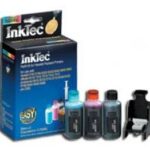If your printer has been acting up lately and you find yourself in need of inkjet printer repair, you will probably find it somewhat helpful to know more about how inkjet printers work and what printer problems are most common with this category of printer.
Inkjet printers were a replacement for the old dot matrix printers that were the only affordable option to laser printers for many years. Unlike the dot matrix printers that used an impact across a ribbon to produce an image on paper, the technology behind inkjets allows the image to be transferred without the cartridge actually coming into contact with the paper.
The tiny droplets of ink in an inkjet printer are actually forcefully pushed out of the head of the cartridge through a matrix of holes. This is done in a systematic and controlled way and with a good deal of comparative force, spraying the ink onto the paper to create the image. It is the controlled force that led to the naming of this new technology as inkjet.
All inkjet printers use this same basic approach and principles in applying ink in a pattern according to what image the computer is feeding to the printer. Inkjet printer repair often starts with being sure that the jets in the ink cartridge are clean and clear of obstruction.
Since inkjet printers were first introduced to the market more than 20 years ago, the quality has improved because of improved technology in controlling the size of the ink droplets. The smaller the droplets are, the better image quality is produced on the paper. Speed and reliability have also improved significantly, especially in the last dozen years with a major improvement in the actuator print head, which is the part that contains the numerous tiny nozzles that sprays into onto the paper.
Another, similar advancement was introduced with micro-piezo technology that uses a crystal embedded in each tiny nozzle and when the crystal is given an electrical charge. This would cause vibration that would cause a controlled amount of ink to de dispersed onto the paper.
Additional changes have come along for inkjet printer, which have taken them from being rather slow and low quality to being able to compete right alongside of the more expensive laser printers.
The real key to quality is what is referred to as resolution. Resolution is referred to as dots per inch, DPI, and the higher the resolution, the better the quality of the printed piece. When inkjets were first introduced the DPI was around 120. In the early 1990’s technology brought the DPI up to 360, which was considered almost “letter quality” for the time. The some inkjet printers available today can print at 6000 DPI, making it almost impossible for the naked eye to tell the difference between a photo printed on a high quality inkjet and a print made through photo processing.
Because inkjet printers are now able to deliver great printing speeds, high quality printing and good reliability, they will continue to be popular and inkjet printer repair even more important.



